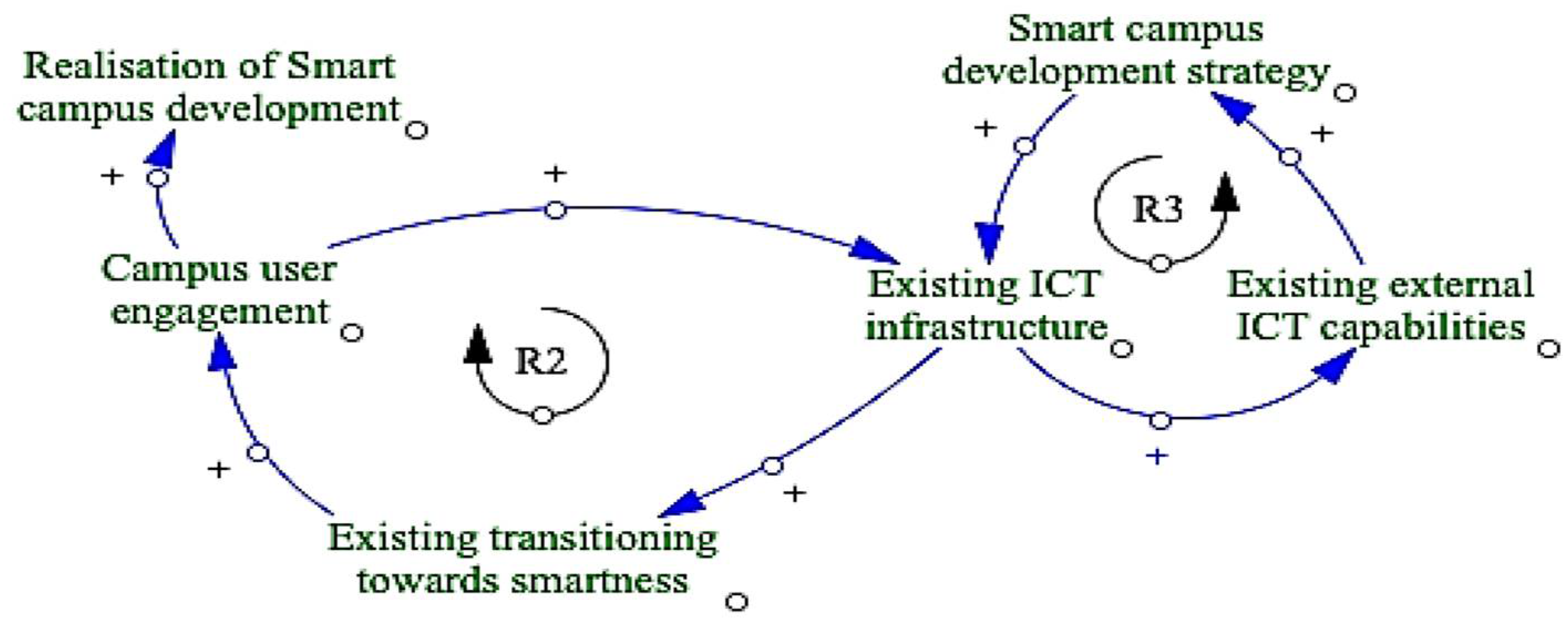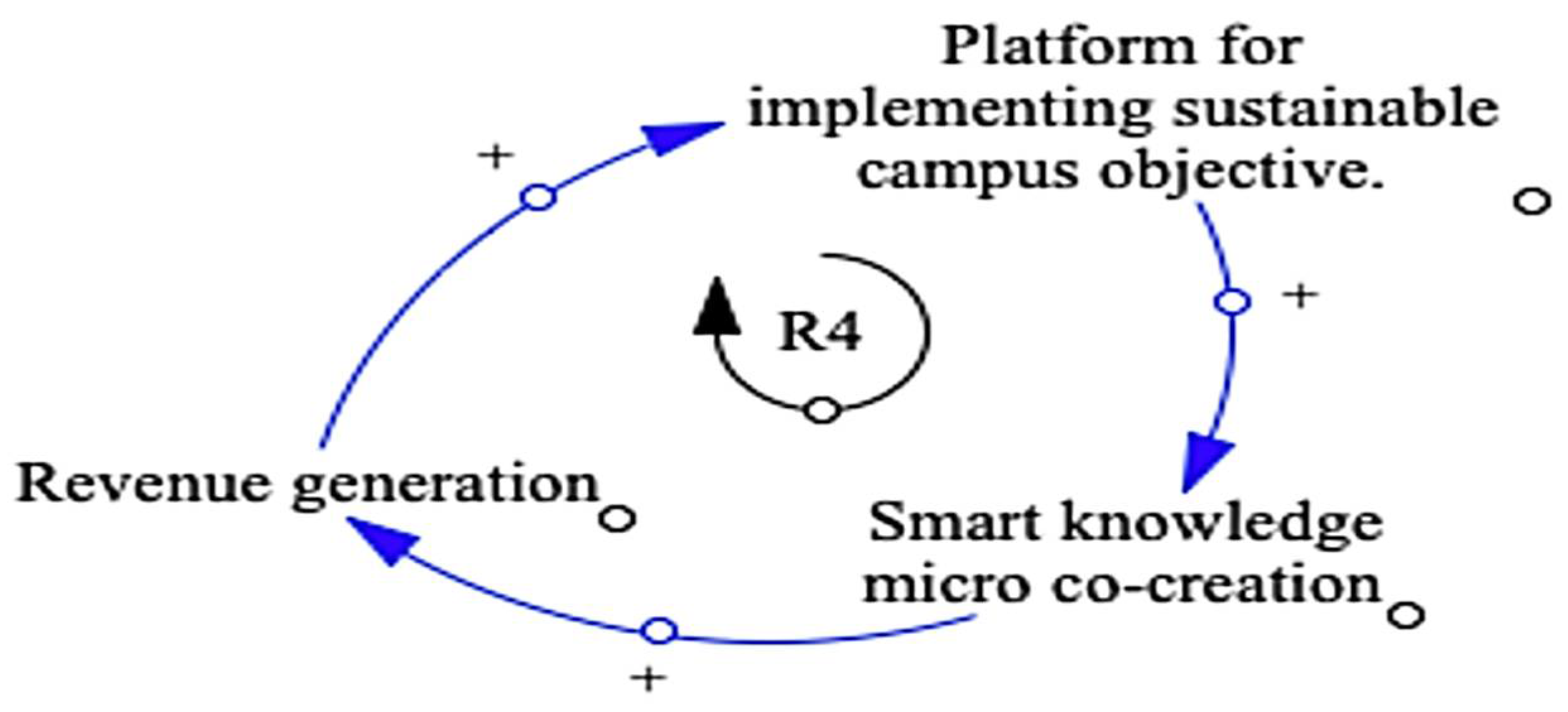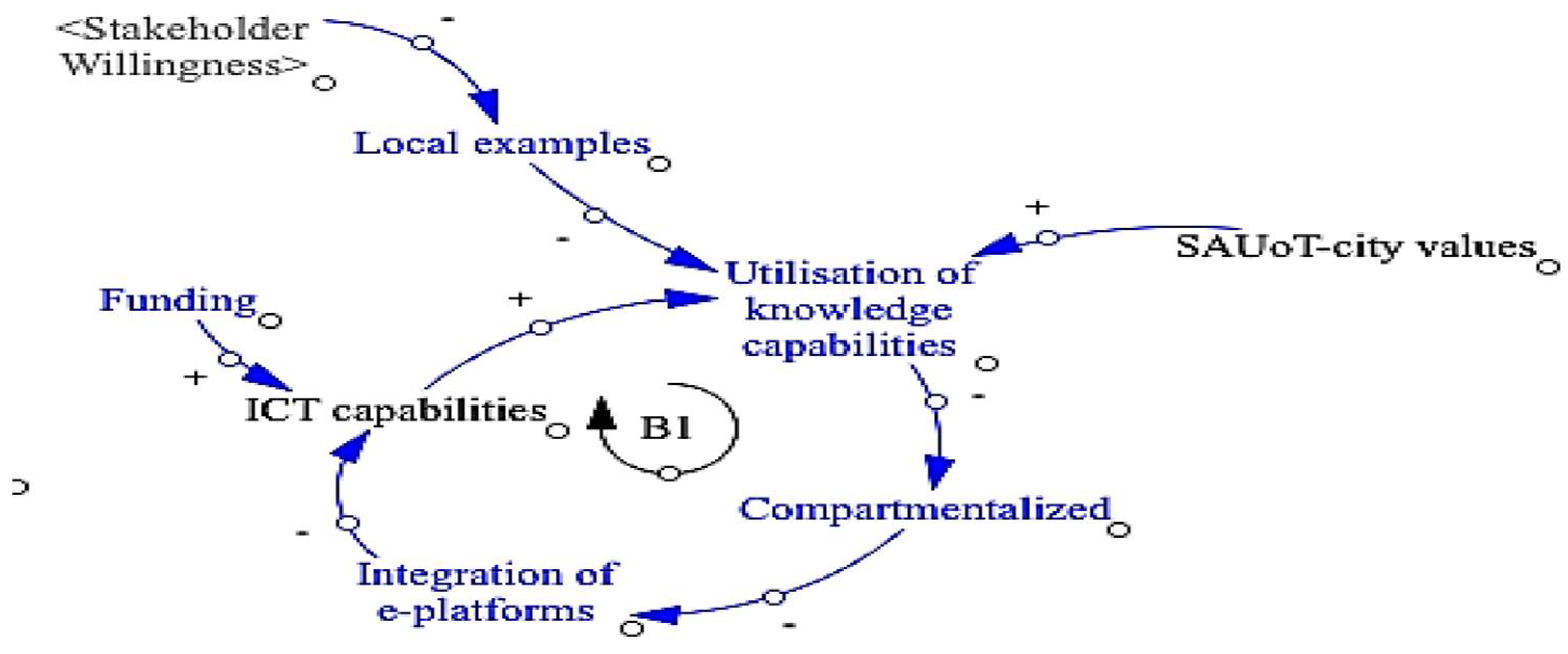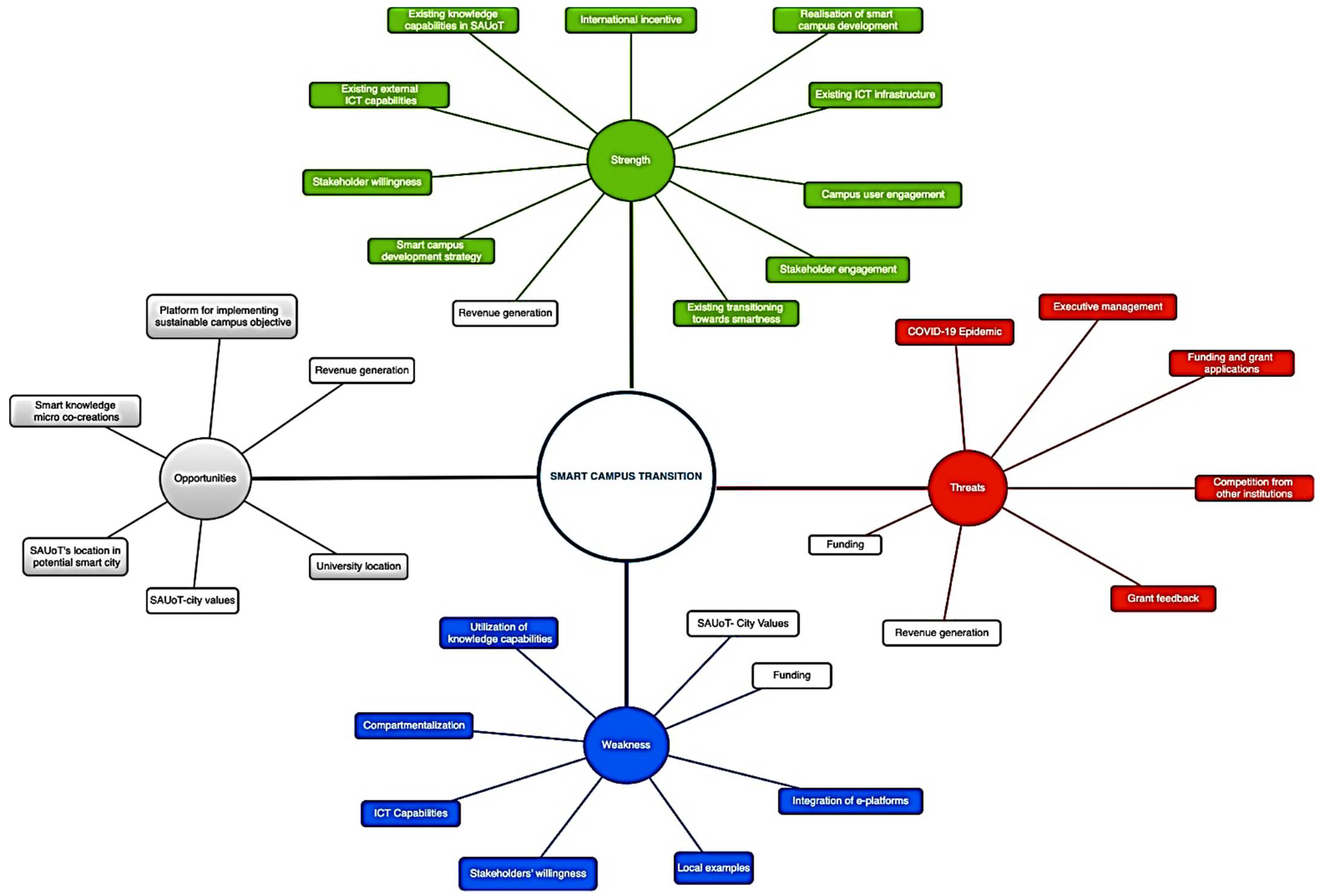Facilitating Successful Smart Campus Transitions: A Systems Thinking-SWOT Analysis Approach
Abstract
1. Introduction
2. Literature Review
2.1. Defining the Smart Campus
2.2. Characteristics of a Smart Campus
3. Materials and Methods
3.1. Description of Case Study Context (SAUoT)
3.2. Data Collection
- A context-specific definition of the Smart Campus;
- Stakeholders’ expectations of a Smart Campus environment;
- An appraisal of the state-of-art Smart infrastructure at SAUoT; and
- A SWOT analysis concerning the transition towards a Smart Campus environment.
3.3. Validation of SWOT Causal Loop Diagram
- (1)
- Are there any missing variables from the list?
- (2)
- Please can you briefly indicate any variable that should be linked to each other?
- (3)
- Considering the structure of the causal loop diagram, do you think this diagram represents a SWOT for a Smart Campus implementation?
- (4)
- Do you think the causal loop diagram is simple enough?
- (5)
- Are there any ambiguities in the causal loop diagram above?
4. Results
4.1. A SWOT Analysis Concerning the Transition Towards a Smart Campus Environment
4.2. Systems Thinking: SWOT Causal Loop Diagram
5. Discussion
5.1. Archetypes for Smart Campus Transitioning
5.2. Developing a Framework for Managing SWOT Factors during Smart Campus Transitions
6. Conclusions
Author Contributions
Funding
Data Availability Statement
Acknowledgments
Conflicts of Interest
References
- Dos Santos, M.L.; Mota, M. Toward sustainable and smart cities in Africa: A review and challenges. In Bioclimatic Architecture in Warm Climates; Guedes, M.C., Cantuaria, G., Eds.; Springer: Cham, Switzerland, 2019; pp. 299–309. [Google Scholar]
- Tan, S.Y.; Taeihagh, A. Smart city governance in developing countries: A systematic literature review. Sustainability 2020, 12, 899. [Google Scholar] [CrossRef]
- Barro, P.A.; Deglia, J.; Zennaro, M.; Wamba, S.F. Towards smart and sustainable future cities based on Internet of things for developing countries: What approach for Africa? EAI Endorsed Trans. Internet Things 2018, 4, 8. [Google Scholar] [CrossRef]
- Oke, A.E.; Aghimien, D.O.; Aigbavboa, C.O. Appraisal of the drivers of smart city development in South Africa. Constr. Economics Build. 2020, 20, 109–126. [Google Scholar] [CrossRef]
- Das, D.K. Perspectives of smart cities in South Africa through applied systems analysis approach: A case of Bloemfontein. Constr. Econ. Build. 2020, 20, 65–88. [Google Scholar] [CrossRef]
- Chirisa, I.; Matamanda, A.R. Smart cities in sub-saharan africa: Opportunities and challenges. In Industrial and Urban Growth Policies at the Sub-National, National, and Global Levels; Benna, U.G., Ed.; IGI Global: Hershey, PA, USA, 2019; pp. 83–99. [Google Scholar]
- Du Plessis, H.; Marnewick, A.L. A roadmap for smart city services to address challenges faced by small businesses in South Africa. S. Afr. J. Econ. Manag. Sci. 2017, 20, 1–18. [Google Scholar] [CrossRef]
- Giffinger, R.; Gudrun, H. Smart cities ranking: An effective instrument for the positioning of the cities? ACE Archit. City Environ. 2010, 4, 7–26. [Google Scholar]
- Lombardi, P.; Giordano, S.; Farouh, H.; Yousef, W. Modelling the smart city performance. Innov. Eur. J. Soc. Sci. Res. 2012, 25, 137–149. [Google Scholar] [CrossRef]
- Fernandez-Anez, V.; Fernández-Güell, J.M.; Giffinger, R. Smart City implementation and discourses: An integrated conceptual model. Case Vienna Cities 2018, 78, 4–16. [Google Scholar] [CrossRef]
- Silva, B.N.; Khan, M.; Han, K. Towards sustainable smart cities: A review of trends, architectures, components, and open challenges in smart cities. Sustain. Cities Soc. 2018, 38, 697–713. [Google Scholar] [CrossRef]
- Purcell, W.M.; Henriksen, H.; Spengler, J.D. Universities as the engine of transformational sustainability toward delivering the sustainable development goals: “Living labs” for sustainability. Int. J. Sustain. High. Educ. 2019, 20, 1343–1357. [Google Scholar] [CrossRef]
- Findler, F.; Schönherr, N.; Lozano, R.; Reider, D.; Martinuzzi, A. The impacts of higher education institutions on sustainable development. Int. J. Sustain. High. Educ. 2019, 20, 23–38. [Google Scholar] [CrossRef]
- Fortes, S.; Santoyo-Ramón, J.A.; Palacios, D.; Baena, E.; Mora-García, R.; Medina, M.; Mora, P.; Barco, R. The campus as a smart city: University of Málaga environmental, learning, and research approaches. Sensors 2019, 19, 1349. [Google Scholar] [CrossRef]
- Ferraris, A.; Belyaeva, Z.; Bresciani, S. The role of universities in the Smart City innovation: Multistakeholder integration and engagement perspectives. J. Bus. Res. 2020, 119, 163–171. [Google Scholar] [CrossRef]
- Verstaevel, N.; Boes, J.; Gleizes, M.-P. From smart campus to smart cities issues of the smart revolution. In Proceedings of the 2017 IEEE Smart World, Ubiquitous Intelligence & Computing, Advanced & Trusted Computed, Scalable Computing & Communications, Cloud & Big Data Computing, Internet of People and Smart City Innovation (SmartWorld/SCALCOM/UIC/ATC/CBDCom/IOP/SCI), San Francisco Bay, CA, USA, 4–8 August 2017. [Google Scholar]
- Vasileva, R.; Rodrigues, L.; Hughes, N.; Greenhalgh, C.; Goulden, M.; Tennison, J. What smart campuses can teach us about smart cities: User experiences and open data. Information 2018, 9, 251. [Google Scholar] [CrossRef]
- Ardito, L.; Ferraris, A.; Petruzzelli, A.M.; Bresciani, S.; Del Giudice, M. The role of universities in the knowledge management of smart city projects. Technol. Forecast. Soc. Chang. 2019, 142, 312–321. [Google Scholar] [CrossRef]
- Villegas-Ch, W.; Palacios-Pacheco, X.; Luján-Mora, S. Application of a smart city model to a traditional university campus with a big data architecture: A sustainable smart campus. Sustainability 2019, 11, 2857. [Google Scholar] [CrossRef]
- Prandi, C.; Monti, L.; Ceccarini, C.; Salomoni, P. Smart campus: Fostering the community awareness through an intelligent environment. Mob. Netw. Applications 2020, 25, 945–952. [Google Scholar] [CrossRef]
- Min-Allah, N.; Alrashed, S. Smart campus—A sketch. Sustain. Cities Soc. 2020, 59, 102231. [Google Scholar] [CrossRef] [PubMed]
- Malatji, E.M. The development of a smart campus-African universities point of view. In Proceedings of the 8th International Renewable Energy Congress (IREC), Dead Sea, Jordan, 21–23 March 2017. [Google Scholar]
- Ahmed, V.; Alnaaj, K.A.; Saboor, S. An investigation into stakeholders’ perception of smart campus criteria: The American university of Sharjah as a case study. Sustainability 2020, 12, 5187. [Google Scholar] [CrossRef]
- Némoz, S. Smart Campus: Recent advances and future challenges for action research on territorial sustainability. In Implementing Campus Greening Initiatives; Leal Filho, W., Muthu, N., Edwin, G., Sima, M., Eds.; Springer: Cham, Switzerland, 2015; pp. 313–323. [Google Scholar]
- Rha, J.-Y.; Lee, J.M.; Li, H.Y.; Jo, E.B. From a literature review to a conceptual framework, issues and challenges for SMART Campus. J. Digit. Converg. 2016, 14, 19–31. [Google Scholar] [CrossRef][Green Version]
- Zhang, Y.; Dong, Z.Y.; Yip, C.; Swift, S. Smart campus: A user case study in Hong Kong. IET Smart Cities 2020, 2, 146–154. [Google Scholar] [CrossRef]
- Ngowi, A.B.; Awuzie, B.O. A user-led approach to smart campus design at a university of technology. In Smart and Sustainable Cities and Buildings; Roggema, R., Roggema, A., Eds.; Springer: Cham, Switzerland, 2020; pp. 433–443. [Google Scholar]
- Central University of Technology. Vision 2030; Central University of Technology: Bloemfontein, South Africa, 2020. [Google Scholar]
- Ngowi, A.B.; Awuzie, B.O. Fostering successful smart campus transitions through consensus-building: A university of technology case study. In Designing Sustainable Cities; Roggema, R., Ed.; Springer: Cham, Switzerland, 2020; pp. 161–183. [Google Scholar]
- Dyson, R.G. Strategic development and SWOT analysis at the University of Warwick. Eur. J. Oper. Res. 2004, 152, 631–640. [Google Scholar] [CrossRef]
- Srivastava, P.; Kulshreshtha, K.; Mohanty, C.S.; Pushpangadan, P.; Singh, A. Stakeholder-based SWOT analysis for successful municipal solid waste management in Lucknow, India. Waste Manag. 2005, 25, 531–537. [Google Scholar] [CrossRef]
- Abdel-Basset, M.; Mohamed, M.; Smarandache, F. An extension of neutrosophic AHP–SWOT analysis for strategic planning and decision-making. Symmetry 2018, 10, 116. [Google Scholar] [CrossRef]
- Živković, Ž.; Nikolić, D.; Djordjević, P.; Mihajlović, I.; Savić, M. Analytical network process in the framework of SWOT analysis for strategic decision making (Case study: Technical faculty in Bor, University of Belgrade, Serbia). Acta Polytech. Hung. 2015, 12, 199–216. [Google Scholar]
- Kajanus, M.; Leskinen, P.; Kurttila, M.; Kangas, J. Making use of MCDS methods in SWOT analysis—Lessons learnt in strategic natural resources management. For. Policy Econ. 2012, 20, 1–9. [Google Scholar] [CrossRef]
- Yüksel, İ.; Dagdeviren, M. Using the analytic network process (ANP) in a SWOT analysis–A case study for a textile firm. Inf. Sci. 2007, 177, 3364–3382. [Google Scholar] [CrossRef]
- Ghazinoory, S.; Abdi, M.; Azadegan-Mehr, M. SWOT methodology: A state-of-the-art review for the past, a framework for the future. J. Bus. Econ. Manag. 2011, 12, 24–48. [Google Scholar] [CrossRef]
- Ghazinoory, S.; Zadeh, A.E.; Memariani, A. Fuzzy SWOT analysis. J. Intell. Fuzzy Syst. 2007, 18, 99–108. [Google Scholar]
- Kheirkhah, A.S.; Esmailzadeh, A.; Ghazinoory, S. Developing strategies to reduce the risk of hazardous materials transportation in Iran using the method of fuzzy SWOT analysis. Transport 2009, 24, 325–332. [Google Scholar] [CrossRef][Green Version]
- Muhamad, W.; Kurniawan, N.B.; Yazid, S. Smart campus features, technologies, and applications: A systematic literature review. In International Conference on Information Technology Systems and Innovation (ICITSI); IEEE: Bandung, Indonesia, 23–24 October 2017. [Google Scholar]
- Dong, Z.Y.; Zhang, Y.; Yip, C.; Swift, S.; Beswick, K. Smart campus: Definition, framework, technologies, and services. IET Smart Cities 2020, 2, 43–54. [Google Scholar] [CrossRef]
- Hipwell, S. Developing smart campuses—A working model. In International Conference on Intelligent Green Building and Smart Grid (IGBSG); IEEE: Taipei, Taiwan, 23–25 April 2014. [Google Scholar]
- Davies, B. Internet of everything ePowering the smart campus and the smart city. In IBM Institute for Business Value; IBM: New York, NY, USA, 2015. [Google Scholar]
- Abuarqoub, A.; Abusaimeh, H.; Hammoudeh, M.; Uliyan, D.; Abu-Hashem, M.A.; Murad, S.; Al-Jarrah, M.; Al-Fayez, F. A survey on internet of things enabled smart campus applications. In Proceedings of the International Conference on Future Networks and Distributed Systems (ICFNDS); Association for Computing Machinery: Cambridge, UK, 19–20 July 2017. [Google Scholar]
- Alrashed, S. Key Performance Indicators for Smart Campus and Microgrid. Sustain. Cities Soc. 2020, 60, 102264. [Google Scholar] [CrossRef]
- Pompei, L.; Mattoni, B.; Bisegna, F.; Nardecchia, F.; Fichera, A.; Gagliano, A.; Pagano, A. Composite Indicators for Smart Campus: Data Analysis Method. In Proceedings of the 2018 IEEE International Conference on Environment and Electrical Engineering and 2018 IEEE Industrial and Commercial Power Systems Europe (EEEIC/I&CPS Europe), Palermo, Italy, 12–15 June 2018. [Google Scholar]
- Hirsch, B.; Ng, J.W. Education beyond the cloud: Anytime-anywhere learning in a smart campus environment. In Proceedings of the 2011 International Conference for Internet Technology and Secured Transactions, Abu Dhabi, United Arab Emirates, 11–14 December 2011. [Google Scholar]
- Shoup, D. Parking on a smart campus: Lessons for universities and cities. In California Policy Options; UCLA School of Public Affairs: Los Angeles, CA, USA, 2005; pp. 117–149. [Google Scholar]
- Bandara, H.M.A.P.K.; Jayalath, J.D.C.; Rodrigo, A.R.S.P.; Bandaranayake, A.U.; Maraikar, Z.; Ragel, R.G. Smart campus phase one: Smart parking sensor network. In Proceedings of the 2016 Manufacturing & Industrial Engineering Symposium (MIES), Colombo, Sri Lanka, 22 October 2016. [Google Scholar]
- Fan, J.; Stewart, K. An ontology-based framework for modeling movement on a smart campus. Analysis of Movement Data, GIScience Workshop, Vienna, Austria, 23 September 2014. [Google Scholar]
- Barbato, A.; Bolchini, C.; Geronazzo, A.; Quintarelli, E.; Palamarciuc, A.; Pitì, A.; Rottondi, C.; Verticale, G. Energy optimization and management of demand response interactions in a smart campus. Energies 2016, 9, 398. [Google Scholar] [CrossRef]
- Lazaroiu, G.C.; Dumbrava, V.; Costoiu, M.; Teliceanu, M.; Roscia, M. Smart campus-an energy integrated approach. In Proceedings of the 2015 International Conference on Renewable Energy Research and Applications (ICRERA), Palermo, Italy, 22–25 November 2015. [Google Scholar]
- Pasetti, M.; Sisinni, E.; Ferrari, P.; Rinaldi, S.; Depari, A.; Bellagente, P.; Della Giustina, D.; Flammini, A. Evaluation of the Use of Class B LoRaWAN for the Coordination of Distributed Interface Protection Systems in Smart Grids. J. Sens. Actuator Netw. 2020, 9, 13. [Google Scholar] [CrossRef]
- Campuzano, F.; Doumanis, I.; Smith, S.; Botia, J.A. Intelligent environments simulations, towards a smart campus. In Proceedings of the 2nd International Workshop on Smart University: The University as a Context Platform, University of West London, London, UK, 14 November 2014. [Google Scholar]
- Dong, X.; Kong, X.; Zhang, F.; Chen, Z.; Kang, J. OnCampus: A mobile platform towards a smart campus. SpringerPlus 2016, 5, 974. [Google Scholar] [CrossRef]
- Valks, B.; Arkesteijn, M.; den Heijer, A. Smart campus tools 2.0 exploring the use of real-time space use measurement at universities and organizations. Facilities 2019. ahead-of-print. [Google Scholar] [CrossRef]
- Huang, L.-S.; Su, J.-Y.; Pao, T.-L. A context aware smart classroom architecture for smart campuses. Appl. Sci. 2019, 9, 1837. [Google Scholar] [CrossRef]
- Gupta, S.K.; Ashwin, T.; Guddeti, R.M.R. Students’ affective content analysis in smart classroom environment using deep learning techniques. Multimed. Tools Appl. 2019, 78, 25321–25348. [Google Scholar] [CrossRef]
- MacLeod, J.; Yang, H.H.; Zhu, S.; Li, Y. Understanding students’ preferences toward the smart classroom learning environment: Development and validation of an instrument. Comput. Educ. 2018, 122, 80–91. [Google Scholar] [CrossRef]
- Li, B.P.; Kong, S.C.; Chen, G. A study on the development of the smart classroom scale. In Emerging Issues in Smart Learning; Springer: Cham, Switzerland, 2015; pp. 45–52. [Google Scholar]
- Ali, Z.; Shah, M.A.; Almogren, A.; Ud Din, I.; Maple, C.; Khattak, H.A. Named Data Networking for Efficient IoT-based Disaster Management in a Smart Campus. Sustainability 2020, 12, 3088. [Google Scholar] [CrossRef]
- Gohari, S.; Baer, D.; Nielsen, B.F.; Gilcher, E.; Situmorang, W.Z. Prevailing approaches and practices of citizen participation in smart city projects: Lessons from Trondheim Norway. Infrastructures 2020, 5, 36. [Google Scholar] [CrossRef]
- Hudson, L.; Wolff, A.; Gooch, D.; Van Der Linden, J.; Kortuem, G.; Petre, M.; ten Veen, R.; O’Connor-Gotra, S. Supporting urban change: Using a MOOC to facilitate attitudinal learning and participation in smart cities. Comput. Educ. 2019, 129, 37–47. [Google Scholar] [CrossRef]
- Mora, L.; Deakin, M.; Reid, A. Strategic principles for smart city development: A multiple case study analysis of European best practices. Technol. Forecast. Soc. Chang. 2019, 142, 70–97. [Google Scholar] [CrossRef]
- Sepasgozar, S.M.; Hawken, S.; Sargolzaei, S.; Foroozanfa, M. Implementing citizen centric technology in developing smart cities: A model for predicting the acceptance of urban technologies. Technol. Forecast. Soc. Chang. 2019, 142, 105–116. [Google Scholar] [CrossRef]
- van Waart, P.; Mulder, I.; de Bont, C. A participatory approach for envisioning a smart city. Soc. Sci. Comput. Rev. 2016, 34, 708–723. [Google Scholar] [CrossRef]
- Paskaleva, K.; Cooper, I.; Linde, P.; Peterson, B.; Götz, C. Stakeholder Engagement in the Smart City: Making Living Labs Work, in Transforming City Governments for Successful Smart Cities; Rodríguez-Bolívar, M., Ed.; Springer: Cham, Switzerland, 2015; pp. 115–145. [Google Scholar]
- Shelton, T.; Lodato, T. Actually existing smart citizens: Expertise and (non) participation in the making of the smart city. City 2019, 23, 35–52. [Google Scholar] [CrossRef]
- Letaifa, S.B. How to strategize smart cities: Revealing the SMART model. J. Bus. Res. 2015, 68, 1414–1419. [Google Scholar] [CrossRef]
- Yin, R.K. Case study Research and Applications; Sage: Thousand Oaks, CA, USA, 2018. [Google Scholar]
- SmartCitiesWorld. South African City Upgrades to Smart City LED Lights. 2016. Available online: https://www.smartcitiesworld.net/news/news/south-african-city-upgrades-to-smart-city-led-lights-926 (accessed on 19 February 2021).
- Das, D. Transforming Bloemfontein City to a smart city-A systems thinking approach. In Proceedings of the Smart and Sustainable Built Environment (SASBE) Conference, University of Pretoria, Pretoria, South Africa, 9–11 December 2015. [Google Scholar]
- Das, D.; Emuze, F. Smart city perspectives of Bloemfontein, South Africa. J. Constr. Proj. Manag. Innov. 2014, 4, 930–949. [Google Scholar]
- Andreani, S.; Kalchschmidt, M.; Pinto, R.; Sayegh, A. Reframing technologically enhanced urban scenarios: A design research model towards human centered smart cities. Technol. Forecast. Soc. Chang. 2019, 142, 15–25. [Google Scholar] [CrossRef]
- Denscombe, M. The Good Research Guide: For Small-Scale Social Research Projects; McGraw-Hill Education: Maidenhead, Berkshire, UK, 2014. [Google Scholar]
- Abbas, H.; Shaheen, S.; Elhoseny, M.; Singh, A.K.; Alkhambashi, M. Systems thinking for developing sustainable complex smart cities based on self-regulated agent systems and fog computing. Sustain. Comput. Inform. Syst. 2018, 19, 204–213. [Google Scholar] [CrossRef]
- Khayut, B.; Fabri, L.; Avikhana, M. Modeling of intelligent system thinking in complex adaptive systems. Procedia Comput. Sci. 2014, 36, 93–100. [Google Scholar] [CrossRef][Green Version]
- Lich, K.H.; Urban, J.B.; Frerichs, L.; Dave, G. Extending systems thinking in planning and evaluation using group concept mapping and system dynamics to tackle complex problems. Eval. Program Plan. 2017, 60, 254–264. [Google Scholar] [CrossRef] [PubMed]
- Miki, Y.; Kojiri, T.; Seta, K. “If Thinking” Support System for Training Historical Thinking. Procedia Comput. Sci. 2015, 60, 1542–1551. [Google Scholar] [CrossRef]
- Omotayo, T.; Awuzie, B.; Egbelakin, T.; Obi, L.; Ogunnusi, M. AHP-Systems Thinking Analyses for Kaizen Costing Implementation in the Construction Industry. Buildings 2020, 10, 230. [Google Scholar] [CrossRef]
- Cabrera, D.; Cabrera, L.; Powers, E.; Solin, J.; Kushner, J. Applying systems thinking models of organizational design and change in community operational research. Eur. J. Oper. Res. 2018, 268, 932–945. [Google Scholar] [CrossRef]
- Omotayo, T.; Olanipekun, A.; Obi, L.; Boateng, P. A systems thinking approach for incremental reduction of non-physical waste. Built Environ. Proj. Asset Manag. 2020, 10, 509–528. [Google Scholar] [CrossRef]









| No. | Sector | Discussant Code | Number of Discussants per Category |
|---|---|---|---|
| 1. | Registry | R1-2 | 2 |
| 2. | Finance/Accounts | F/A1 | 1 |
| 3. | Procurement | P1-2 | 2 |
| 4. | Estates and Infrastructure (Facilities) | FA1-2 | 2 |
| 5. | Information and Communication Technology (ICT) | ICT1-2 | 2 |
| 6. | Student Representatives | SR1-4 | 4 |
| 7. | Academic staff | AS1-6 | 6 |
| Total | 19 |
| Experts | Country of Residence | Profession |
|---|---|---|
| EXP1 | South Africa | Professor of Construction project management |
| EXP2 | South Africa | Senior researcher in built environment |
| EXP3 | United Kingdom | Senior Lecturer in Quantity Surveying |
| EXP4 | United Kingdom | Lecturer in Quantity Surveying |
| EXP5 | New Zealand | Post-doctoral fellow in construction project management |
| Strengths | Weaknesses |
|---|---|
|
|
| Opportunities | Threats |
|
|
| Expert Opinion Codes | Experts’ Comments | Changes Effected |
|---|---|---|
| SA-EXP1 | Inclusion of new SWOT variables: Strength International incentive. Engagement of campus end users. | Strength International incentive. Campus user’s engagement. |
| Weakness Absence of local examples. | Weakness Local examples. | |
| Opportunities Location of campus SAUoT-city aligned values. Presence of similar interests for benchmarking purposes. Similar international guidelines. Platform for implementing sustainable campus objective. International grants. Enhancement of university curriculum. | Opportunities SAUoT’s location in a potentially Smart City was stated. Existing interests for benchmarking. Similar international guidelines. Platform for implementing sustainable campus objective. University curriculum. | |
| Threat Executive management’s interest. | Threat Executive management. | |
| SA-EXP2 | Suggestions stated: Separation of CLDs The CLDs or conceptual models for each aspect may be made separately by considering the most influential parameters and their one way or two-way causalities. | The different models were separated according to the reinforcing loops and SWOT. |
| Structure Think in terms of “information- decision-action- impact” on the system (environment) (information leading to a decision based on which actions are taken and the actions have an impact on the system), then the action will come back as the information as feedback. | The structure of the model was revised according to “information- decision-action- impact”. | |
| Polarities Polarities only influence two consecutive variables and succeeding or preceding to the two concerned consecutive variables are not impacted by the polarities assigned to the two variables. For example, IF there are four variables linked in a feedback loop A-B-C-D, then A influences the polarity of B but does not influence the polarity of C. | The polarities have been revised accordingly. This is evident in R1, R2, R3, and R4. | |
| Balancing loops Even number of negatives becomes positive and adds to become a reinforcing loop and odd number negative becomes negative and generates a balancing loop (ll balancing loops are not bad—they are needed to stabilize the system). | The change in structure and variables have led to new balancing loops. | |
| UK-EXP1 | Suggestion stated: Description The model is concise, and it described the issues associated with the transition to Smart Campus within the tertiary educational sector. | The positive feedback was used to enhance the structure and polarities. |
| UK-EXP2 | Suggestion stated: Clarity The model is not very simple to understand in some respects as it is not clear to understand the connections in a few places. For example, it is not clear how stakeholders’ engagement leads to unwillingness of stakeholders as a weakness. Also, how can unwillingness of stakeholders, result in utilization of knowledge capabilities or do you mean underutilization? Not clear how Smart knowledge micro co creation is an opportunity for compartmentalization? Where possible the links can be better described for clarity. | More neutral words were used to describe the variables. “Unwillingness of stakeholders” has been renamed as “stakeholder willingness”. The connections of knowledge capabilities were revised. |
| NZ-EXP1 | Suggestions stated: Summary and further explanation The reinforcing and balancing feedback loops are clearly indicated to enable experts understand the system. However, R1-R4; B1 needs to be summarized to increase clarity, especially for higher education stakeholders who do not have the knowledge of system dynamics. | Archetypes were produced in addition to the new structure. The archetypes will be explained individually. |
| Clarity on “government policy” Government policy is linked to R1; R3; and R4. Any significance considering it is not one of the SWOT variables in Table 1? Same thing applicable to “economic issues” linked to R4! | There are new variables, reworded variables, and connections in the CLD has changed and there are new reinforcing and balancing loops which will be explained in a separate section. |
Publisher’s Note: MDPI stays neutral with regard to jurisdictional claims in published maps and institutional affiliations. |
© 2021 by the authors. Licensee MDPI, Basel, Switzerland. This article is an open access article distributed under the terms and conditions of the Creative Commons Attribution (CC BY) license (http://creativecommons.org/licenses/by/4.0/).
Share and Cite
Awuzie, B.; Ngowi, A.B.; Omotayo, T.; Obi, L.; Akotia, J. Facilitating Successful Smart Campus Transitions: A Systems Thinking-SWOT Analysis Approach. Appl. Sci. 2021, 11, 2044. https://doi.org/10.3390/app11052044
Awuzie B, Ngowi AB, Omotayo T, Obi L, Akotia J. Facilitating Successful Smart Campus Transitions: A Systems Thinking-SWOT Analysis Approach. Applied Sciences. 2021; 11(5):2044. https://doi.org/10.3390/app11052044
Chicago/Turabian StyleAwuzie, Bankole, Alfred Beati Ngowi, Temitope Omotayo, Lovelin Obi, and Julius Akotia. 2021. "Facilitating Successful Smart Campus Transitions: A Systems Thinking-SWOT Analysis Approach" Applied Sciences 11, no. 5: 2044. https://doi.org/10.3390/app11052044
APA StyleAwuzie, B., Ngowi, A. B., Omotayo, T., Obi, L., & Akotia, J. (2021). Facilitating Successful Smart Campus Transitions: A Systems Thinking-SWOT Analysis Approach. Applied Sciences, 11(5), 2044. https://doi.org/10.3390/app11052044







